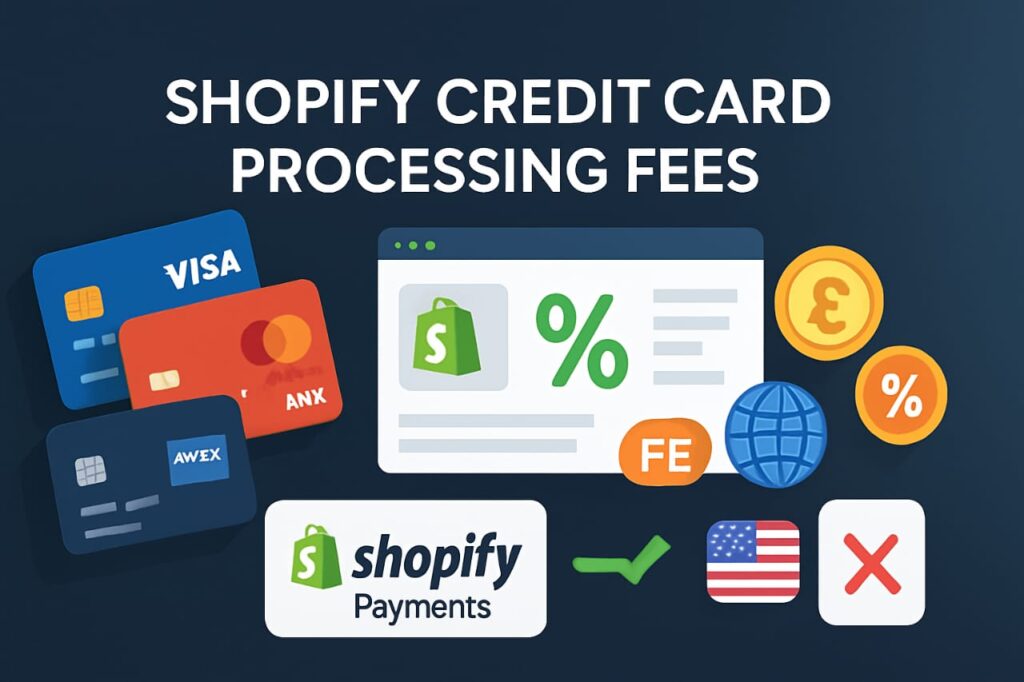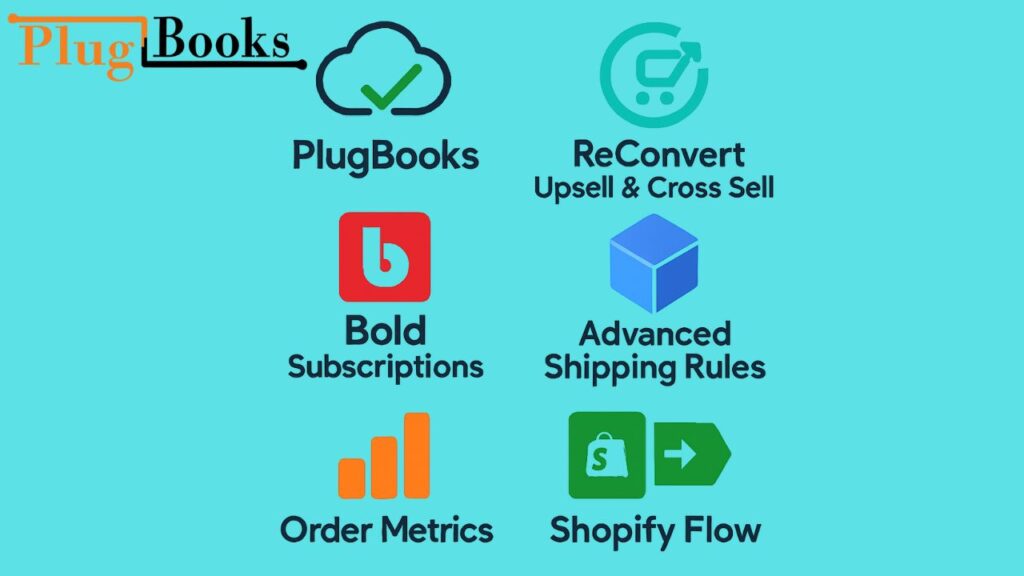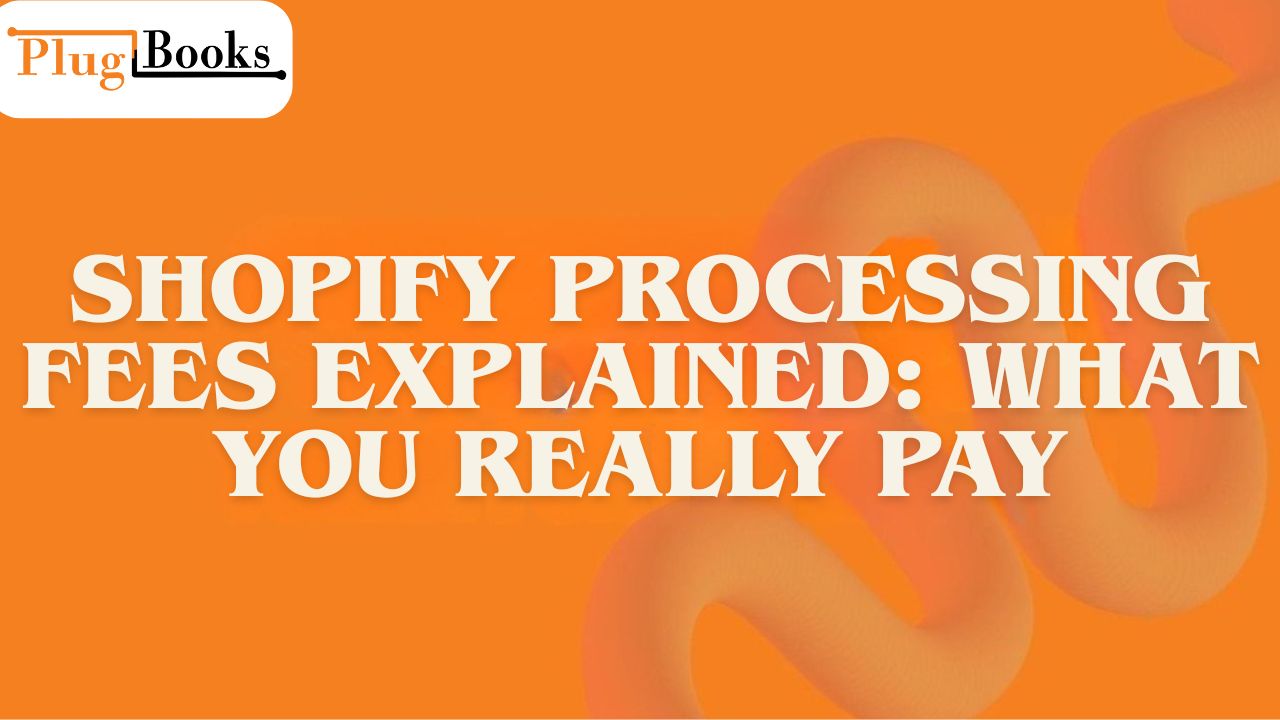Shopify processing fees can seem like a hidden cost that adds up quickly if you have an online store. These are the fees you have to pay every time you sell something and take a customer’s money. Knowing how they work will help you set the right prices for your goods and keep your profits safe.
It’s important to break down these fees, look at your options, and discover ways to lower them, whether you’re just starting out with Shopify or growing your business. We will go over the essentials in this guide and answer your most important concerns in plain language and with real-life examples. For example, we’ll talk about how Shopify payment processing fees affect your income.
Key Takeaways
- Shopify processing fees vary by plan and payment method.
- Shopify payment processing fees are lower with Shopify Payments.
- All plans include some level of processing charges.
- You can’t negotiate standard fees unless you’re a high-volume merchant.
- Use tools like PlugBooks to track and reduce fee impact.
How Much Are Shopify’s Processing Fees for Each Sale?
One of the first questions new merchants ask is, “How much does Shopify charge for each sale?”
Two important things will determine the answer:
- Your Shopify plan (Basic, Shopify, or Advanced)
- The way you pay (Shopify Payments or a third-party service)

Here’s a basic breakdown of Shopify Payments:
| Shopify Plan | Online Credit Card Rate | In-Person Rate |
| Basic | 2.9% + 30¢ | 2.7% |
| Shopify | 2.6% + 30¢ | 2.5% |
| Advanced | 2.4% + 30¢ | 2.4% |
For example, if you sell anything for $100 on Basic Shopify, your Shopify’s processing fees would be $3.20 ($2.90 + $0.30).
Depending on the number of orders, payment methods, and country, your total Shopify payment processing fees may be different. Keep a tight check on your statistics to find out how much each transaction really costs.
For detailed insights, check out this guide: How much does Shopify take per sale?
Does Shopify Charge Processing Fees on All Plans?
Yes, all Shopify plans have processing costs, but the fees go down when you move up to a higher plan. That’s one reason why a lot of sellers think about upgrading to the “Shopify” or “Advanced” plans as their business expands.
Shopify charge processing fees still apply, even if you use a third-party payment gateway like PayPal or Stripe. These providers also charge extra fees. These fees are added to your total Shopify payment processing fees, and if you don’t handle them well, they may significantly eat into your revenues.
👉 Want to know exactly how much Shopify takes per sale? Read this detailed breakdown to get full clarity.
What Are the Credit Card Processing Fees on Shopify?
The most common fees you’ll have to pay on Shopify are for processing credit cards. These rules apply every time someone pays using a Visa, Mastercard, American Express, or a card like that.
As was mentioned before, these prices change depending on the plan and also on:
- Transactions within the country vs. those outside of it
- If you use Shopify Payments
You won’t have to pay the extra 0.5% to 2% cost that Shopify charges for third-party payment processors if you utilize Shopify Payments. A lot of merchants choose to stay within Shopify’s native system because they want to keep their Shopify credit card processing costs and Shopify payment processing fees as low as they can.
👉 To see exactly how much Shopify takes from each sale, check out this full guide: How much does Shopify take per sale?

Are Shopify Payment Processing Fees Negotiable?
So, can you negotiate the fees for processing payments on Shopify?
In theory, no. Most of the time, they are set depending on your plan. There are, however, a few exceptions:
- Shopify Plus lets sellers who sell a lot of items talk directly to Shopify about getting lower rates.
- If you use Shopify Payments instead of a third-party service, you might be able to lower your rates.
It’s still a good idea to keep an eye on your Shopify processing fees and Shopify payment processing fees with financial tools, even if you can’t haggle directly. This will help your business run better.
PlugBooks is an excellent solution that provides real-time reports on all your transactions and fees, helping you stay on top of your costs.
For official details on Shopify’s pricing, visit their payment terms and fees page.
Do I Pay Processing Fees if I Use Shopify Payments?
Yes, you still have to pay processing fees with Shopify Payments, but they’re lower than with other payment gateways. The good thing about Shopify Payments is:
- No extra fees for transactions
- Faster payments
- Better connection with the dashboard of your store
One of the best strategies to minimize Shopify processing fees and overall Shopify payment processing fees is to choose Shopify Payments. If you use PayPal or another service, you’ll have to pay both their costs and an extra fee to Shopify.
For sellers looking to keep track of all their fees and transactions easily, PlugBooks offers real-time financial tracking and payment insights to help you optimize your store’s profits.
Can I Reduce Shopify Processing Fees with Third-Party Apps?
Of course! A lot of sellers want to know if they can lower Shopify’s processing fees with third-party apps.
Yes, there are a couple ways to do this:
- Apps like PlugBooks that help you keep track of your payments show you how much you’re paying in Shopify payment processing fees.
- Apps for upselling or subscriptions can help raise AOV (average order value), which can help pay for costs.
- Shipping rate calculators lower the chances of getting a refund or chargeback, which saves you money in the long run.
For tips and tools to set smarter shipping prices, check out this guide on Shopify shipping rates.
These tools won’t get rid of fees, but they can help you keep your Shopify processing fees low and keep track of where your money is going.

More questions and answers about Shopify processing fees
1. Why does Shopify charge fees for processing?
Shopify charges processing fees to pay for the safe handling of credit card payments and payment gateway services.
2. Are there any hidden fees for processing on Shopify that I should know about?
No, although depending on where the buyer is and how you set things up, there may be fees for international and currency exchange.
3. What effect do Shopify’s processing costs have on refunds?
Shopify will give you back the cost of the item if you issue a refund, but they normally won’t give you back the processing fee.
4. Do manual orders have to pay Shopify’s processing fees?
Yes, if the payment is made by a credit card or gateway. There are no fees for cash-on-delivery or unpaid test orders.
5. Do the fees for processing on Shopify change over time?
Yes, Shopify can change how much they charge, especially when they add new features or payment partners. Always check your admin settings to see what’s new.

Final Thoughts
If you want to run a successful store, you need to know how Shopify’s processing fees work. And when you know how much Shopify charges for payment processing, you have even more control over your money.
These costs may seem minor, but they build up quickly, especially if you don’t keep an eye on them. You may ease the financial burden by picking the correct package and using Shopify Payments and third-party technologies.
Need assistance getting going? All in one location, PlugBooks can provide you with improved Shopify accounting, automated reports, and fee visibility.



